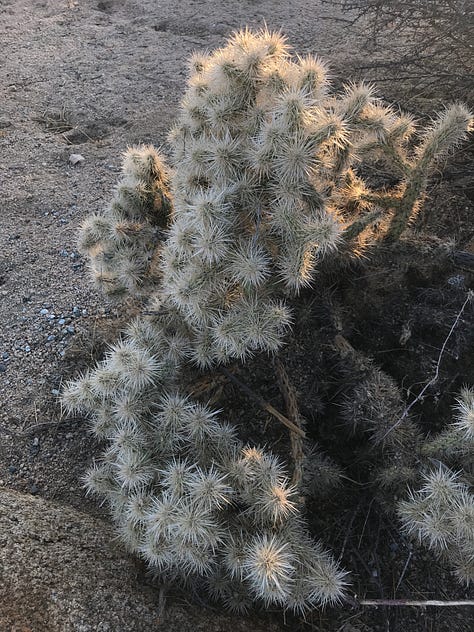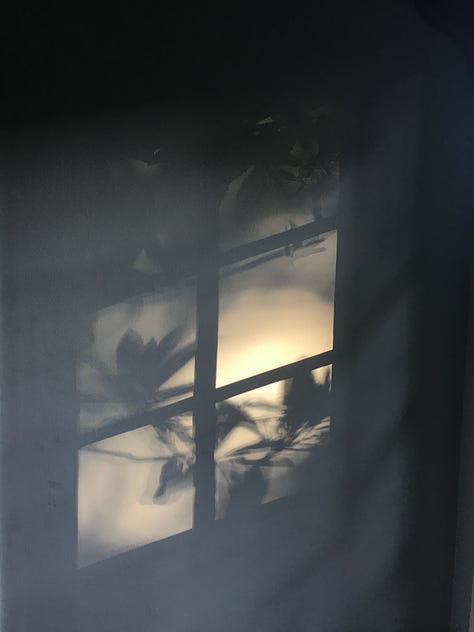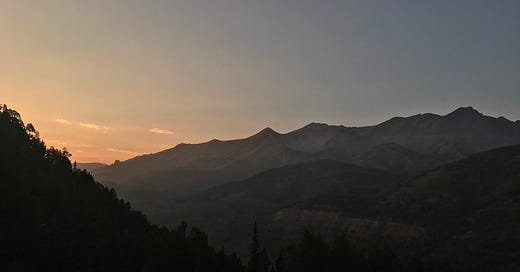As the season grows, teaching is expanding: sign up for workshops in NYC + Chicago in April. Flow with ink, breath, wonder, paper in an upcoming class. To start, strengthen, or sustain a creative journaling or meditation practice, try a virtual 1:1 session. As always, listen to these essays here, and pair your creative practice with a journal or card from Odette Press.
I heard thoughts howl as if they were the still-Winter wind blowing. Snarling, sounding, the wind roared, enveloping ear drums, grit and cold, as if spitting loud and harsh through the sharp of bared teeth. Until thinking stopped. Mind dropped down into the exhale of body, and teeth became a pause, then a smile, and thoughts walked slowly, silently, breath more pant than loud call. Softening.
I was post-run, then, standing on the edge of the road in the wind-down part of the morning. Mid-Winter. Five miles in, having found a flow state, I’d taken myself to a new edge: one of lungs, and breath, of pacing, and distance. Pausing, listening, and waiting to cross the street, I felt my heartbeat morph from frenetic and erratic to slowing in the stand-still, mouth open and teeth bared and breathing hard, panting under the metal howl of the oncoming trains.
I found stillness under the dark evergreen of city trains and peeling paint, looking up to find sky and light between those metal structures holding up the above-ground train; I felt more like an animal those mornings, reaching flats and paces as the cold howled on. Tune to breath, feel weather, breathe the day, I ground into the run, feeling feet rove around, remembering the instinctual and the embodied.


Now, in the morning, the wind still howls. It cuts through my layers, straight to bare arms. Wind, it’s said, will get into crevices; whip you around; can cause sickness. Now, Spring, the in-between: a time where the season teases in temperature, a hint of sun and warmth, while arms, eager to be revealed, still need protection from the winds — still howling, a low call along the horizon, sometimes biting.
Winter, wolf, wind. For several seasons, I’ve felt a pull, a call, to revisit books that reminds me to turn inside, seek, and find, to restore the landscape of inwardness. Winter: the season to prepare. Spring: the season to emerge. Both: seasons where I find myself reading. I want to find the voice of the inner world: one that is found through sensing and sounding, the one that leans more toward the whisper of sensitivity; in Winter, I revive myself with a revisit to Women Who Run with the Wolves as the year starts, as I start to remember the nutrient density of the season. “A healthy woman is much like a wolf: robust, chock-full, strong life force, life-giving, territorially aware, inventive, loyal, roving,” Clarissa Pinkola Estés writes. “Yet, separation from the wildest nature causes a woman's personality to become meager, think, ghostly, spectral.”
One Winter night, I realized I’d been living in the ghosts of the mind, instead of the quiet of the body. Body, where all lineages of fear and wisdom, joy and trauma, equal, live, activated by some sound, taste, nourishment, or story. Later, I’d watch as a pack of wolves call a sound through the glow of my phone screen, their howls low and slow, sustained and repeating. One wolf howls first, often calling up others, and the howl erupts, filling up the atmosphere of forest, the trees’ canopy, and Estés goes on to write about the commonality between wolves and women — though I write this now and widen the scope to say people:
“Both share a wild spirit. Women and wolves are instinctual creatures, able to sense the unseen. They are loyal, protective of their packs and their pups. They are wild and beautiful. Both have been hunted and captured. Even in captivity, one can see in the eyes of a woman, or a wolf, the longing to run free, and the determination that should the opportunity arise, whoosh, they will be gone.”
Not so dissimilar from our human voices, through voice, wolves communicate to locate, to claim territory, and to express their affection; from our voices come both call and the sound of story through the mouth of time from which comes texture, taste, flavor, tone. A story can revive us; deplete us; leave us with a bubbling up, or leave us, at times, with a strange or beautiful aftertaste; can enliven our visions and senses; can draw us forward in life. We rove. We tend. We bare teeth, we bear story, we learn to lick the wounds.
As the year started, I roared through How to Cook a Wolf by M.F.K Fisher, revived by her resource, her instruction, her prose, and her tenacity. In February, I’d listen to more stories, on more mouths and wolves, told here by Sharon Salzberg, of a tale, attributed to Indigenous lineages, of choosing between two wolves, the choice between which mouth to feed. In Salzberg’s telling, one wolf is “fearful, vengeful,” while the other is “peaceful and compassionate” and as we learn to pay attention to our thoughts and actions, we choose which mouth to feed, and therefore strengthen. Fisher likens the process of cooking, of roving, and resourcing, and finding, as a way of staving off the snarling, door-sniffing wolf — the hunger of cooking in scarce times — and both books speak to the language of consciousness, and choice; of caring and nourishment.
What stories feed you, and which wolf do you feed? Food, like breathing, and sitting, and writing, or anything regarded as practice, is an act of expression, and stories as Estés continues, are “the simplest and most accessible ingredient for healing”. A mouth is a doorway to breath, voice, sound, and nourishment, a doorway to story, song, and howling. Connected to the belly, the basin, the heart, your body is an instrument, and practice, as in cooking, breathing, or storytelling, is an act that bears repeating. You inhale a vast, deep breath, and from the wind of tone in your torso comes voice, and sometimes stories agitate you or arouse you, some feed you, and some come to teach you to soothe, to feel, to think, to wonder, to soften.
Before page, stories were told through the cavern of heart, sung out loud from the cave of the mouth. Before matter was printed, it lived in our minds, hearts, and bodies. We told our stories through open mouths of sound, mouths and eyes wide in awe and wonder, slowing down to take in story and food and sound, encircled with each other. We told in silence and noise, in laughter, or told stories to connect, to teach, to strengthen, and as I write this, I think about my ancestors, present and past, tracing their lineages as if they were shorelines, roving to find the sources of taste, story, and strength, while their faces, at times, are only sensed and faint. Food, same as story, can activate at once memory or fear, draw up softening or strength, and I think about the present moment as a long line of small actions that bear repeating. I wonder what stories my ancestors would share — and sometimes, in the faintest dark of night, walking home from the N train, I listen in closely, and I feel their stories, and listen deeply to what they have to say.
How to Cook a Wolf is a reminder of noticing, of thoughtful creating, of resourcing, an instruction where presence of force or metaphor of wolf served as a reminder for me to draw up from the lines of family who knew much about food and economy, the stories of those who came before me, those whose efforts to nourish, create, and provide were as much bridging a divide between needs being met as much as a language of love for the living. Transitioned on, but still present, I draw up from them whenever I find I need psychic caring and I feel their understanding, grounding, nourishing. In Winter, I ripped through that book, then cooked, and felt myself settle: a howl, into a low call, then sustained, for caring and connecting.
Sometimes, I have howled or silenced, and often I have wondered about the stories that run through me, us, each as single threads and collectively. I have howled low, slow, head back loud in laughter, snarled through teeth, and called out in both anxiety and affection, other times howling into the eyes of wonder, or through tears of joy into nights of taste and care and life and plate.
What stories are alive, what are mine, or what’s larger than me? I ask the Winter evenings. What’s a lingering knot, what’s ours to untie, to gather around, to make easy? And more, not only what wolf am I feeding, what mouth, but what am I creating? Estés writes of “a basic nutrition for the soul,“1 while Fisher calls up the presence of “a basic thoughtfulness,”2 in the act of cooking, encouraging the use of any scrap, any juice, any nourishing, edible vestige and I’m reminded of how thoughtfulness can be an ingredient for nourishment: what we are thinking, breathing, eating, how we are moving, roving, what we are seeking for, howling about, how we are being, and what we are repeating.



Years ago, alone, driving, I slept overnight in Joshua Tree. Alarmed, I’d wake to the song of canine, closeness — the yips, and howls of coyotes, the song of the desert at three in the morning. Protected by my thin tent, I looked up and out, seeing no animals but hearing song and finding starlight, alarmed by the sounds of their howling. I’d been driving for weeks — determined, I think, to give myself my own road: a way to assert the thread of wildness and womanhood into modernity, into the language of what I’d read as an eager teenager, lapping up the rhythm and roam of page after page of the Beat generation. But that trip howled, and I took myself to a psychic edge, until eventually I paused and softened, deciding to drive back. Now, when something howls, I pause. I lick the wound. I ask the breath and the body and the ground what it needs. Often, it’s water. Often, it’s simple. Often, it’s sunlight or sleeping. I learn to tend.
We may whisper, laugh, yip, speak, howl, call, or sit silently, and whether wolf in mind or story, in life or practice, repetition can pull you either onward and forward or in loops. Recalling “Howl”, by Allen Ginsberg, I remember the lines of his time, a moment when agitation became the ground by which his voice came forward, and how the poem pulsed through with rhythm and energy.
There is a loyalty that grows in the act of nourishing, of repeating, expressing, and tending, an in returning to ourselves, as in breath, body, in thinking and caring. I’m with you in Rockland, Ginsberg repeats, and there is a great loyalty to the intensity in “Howl”, similar to a rhythm found in the act of cooking and creating, of expressing, and vocalizing. Ginsberg’s time saw, like now, many reasons to howl, to cry out, for many of the same reasons we see today. I’m with you is a way to connect, to recognize; an affirmation of presence, and through nourishing, and noticing, breathing and being, we learn the loyalty of staying with ourselves. We hear the wolf of the mind, of story, of body, and learn to choose the mouths we feed, of suffering or compassion. I’m with you becomes the wolf howl, the low call, a way of care to each other, and ourselves: the parts that snarl out of fear, the parts that hunger from some story, some need, some longing. To voice is to care for ourselves, to bare teeth, to see what we can bear, to bear what we can stand, to use language and voice to stand for something.
There is the language embodied and learned that speaks to what we howl for, what we rove towards, what we grit our teeth as in held back yell or what we snarl or lap for. We each have a voice, and many ways to language; you have your breath, and your center, you have your voice there; and it bears repeating. And so we choose which wolf to feed: fear or peace, laugh or cry, and it makes sense to throw one’s eyes skyward in radical joy, to find each other and feel, while throwing heads back, mouth open, to howl, to laugh. I’m with you in Oakland, in the ocean, in any city, in the darkness, on the bridges, in Maryland, on the highway, in the blazes of horizon, across roads of world, now and in memory, I tell myself. I learn to cook, to breathe, to write, to listen, as if all the inner voice in me wanted to say for so many years was I’m with you and you’ve got this.
What bares teeth, what bears repeating? Food and breathing are arguably the smallest things we do each day to nourish ourselves, and each give us ground for growing. Fig leaf opens into green, as if a tree’s growing teeth, and we bare teeth to smile and snarl, and use tooth to bite fruit. Meanwhile, the figs grow — a slow rhythm to show the slow growing and the hope of passing time. A mouth is not a perfect circle, but it opens, like bloom, so as to sound, to howl, to call out, to express. What nourishes you? What stories do you feed?
The wind is a wolf, the wind is a wall of sound, the wind is roving around howling, and the wind howls as I run into it. I sense running in Winter, as does food, gave me a new language: a place to be quiet and loud, wind so loud I could fierce and howl in, a way to be in the harsh and understand it but not become it. To feel the bite, and bare teeth, and turn the hardened snarl into the bloom of a smile in its place. A wolf, a mouth, a voice, a sound, each other — everyone hungers. Mouth: a place for song, sound, snarl, love, silent, loud, for food and forgiveness. Choose the wolf of wildness, the mouth of wonder, of connection, the breath into darkness, the low and low and low and slow howl into a darkening night, the one that wakes, constellating calls out across each other. A gift: to howl with voice, with laughter, to choose stillness. To speak, to feed the wolf of peace, to eat, to nourish.
From a Past Season:
Nourished By, Nourishing:
Reading “Here Come the Lionfish” by James Bridle in Emergence Magazine. Cooking leftovers. Joy in friendships, walks, nights, winding talks, deep breathing, growing sunlight, dreaming, and writing. Listen here for a March playlist.
Books purchased through the links above are part of an affiliate program. You support small bookstores, add to your libraries, and I receive a portion of commissions in the process. Thank you for your continued support of this work!
“For some women air, night, sunlight, and trees are necessities. For others, words, paper, and books are the only things that satiate. For others, color, form, shadow, and clay at the absolutes. Some women must leap, bow, and run, for their souls crave dance. Yet others crave only a tree-leaning peace." Women Who Run With the Wolves, Clarissa Pinkola Estés
“ . . . there is a basic thoughtfulness, a searching for the kernel in the nut, the bite in honest bread, the slow savor in a baked wished-for apple. It is this thoughtfulness that we must hold to, in peace or war, if we may continue to eat to live.” How to Cook a Wolf, M.F.K Fisher







